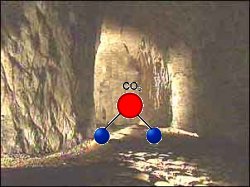
February Editorial
Natural Stores of Carbon Dioxide

February Editorial
Natural Stores of Carbon Dioxide
|
|
Carbon Dioxide (CO2) is the main contributor to global warming and there is mounting pressure for lower levels of carbon emissions. But recent studies led by earth scientist Dr Stuart Gilfillan have shown that in future it may be possible to capture the CO2 produced in the power stations and store (sequester) it underground. But but before this can happen, the process first must be shown to be feasible and safe. Geologists looking for petroleum have already discovered natural CO2 gasfields in the greater Colorado Plateau region and the Southern Rocky Mountains region. The concentration of CO2 in the underground reservoirs here is frequently greater than 98%. These natural underground stores provide an excellent source for the studying of the long-term effects of underground CO2 storage, something which it is not possible to study in a laboratory environment. Most CO2 fields are similar to conventional natural gas fields, with the gas trapped in dome-like structures. The most common reservoir lithologies (rock composition) are sandstone and dolomite, with mudstone and anhydrite being the most common sealing rocks. One of the task of Dr Stuart Gilfillan's group was to find out both how these CO2 reservoirs were created and how long ago this happened. This would establish how stable the underground deposits are, and whether CO2 stored underground will leak into overlying water sources and, if this does happen, whether these natural leaks have any significant environmental impact. The group has analysed CO2 samples from 5 natural gas fields in Colorado Plateau. Their research focused on measuring the noble gases within the carbon dioxide samples. (Noble gases are the elements in group 18 of the of the periodic table, also known as helium family. The gasses in this family, which include helium, neon, argon and krypton, are chemically very stable and rarely react with other elements). By measuring the noble gasses in CO2 samples, the researchers could 'fingerprint' the CO2 in their samples. Their results show that the gas accumulated following degassing of molten magma within the Earth's crust. By looking at the volcanic activity in these areas they concluded that the CO2 has been in the reservoirs for at least eight thousand years (6000 BC being the last known magma melting geological event in the area). In three of the fields being studied the last magma melting event was estimated at over a million years ago with one of them being at least 40 million years old - which means that the gas has been stored there for 40 million years. This means that, if done properly, underground CO2 storage should be safe until we find a better way of dealing with excess CO2 - and a minimum safe storage period of 40 million years would certainly make the issue less urgent. The remaining challenges now are to find appropriate sites for CO2 storage and separating CO2 from the flue gases of coal-fired power plants. Dr Gilfillan's research has been funded by by the Natural Environment Research Council (NERC) and the results published in the February issue of the Geochimica et Cosmochimica Acta (15th February 2008, Vol 72, No. 4, p1174-1198). |
| _______________________________ | ||||
| Home | | | Shopping | | | Database |
© Biscuit Software 2004-2015
All rights reserved